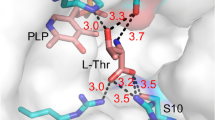Abstract
Objectives
To improve the thermostability and organic solvent tolerance of L-phenylserine aldolase, the in vivo SpyTag/SpyCatcher cyclization strategy was applied in this work.
Results
The in vivo cyclization of L-phenylserine aldolase was achieved by fusing the tags of SpyCatcher and SpyTag to the N- and C-termini of the enzyme, respectively. The kcat values and the circular dichroism spectra of the linear and cyclized LPAs are very similar, indicating that the cyclized LPA can be folded appropriately like the wild type. The cyclized enzyme has better thermostability and organic solvent tolerance than does the wild type. The half-life of L-phenylserine aldolase after cyclization was increased by 8.3 times at 70 °C, and the T50 also increased from 56.8 to 67.1 °C. The cyclized enzyme showed a remarkably higher tolerance to organic solvents (e.g., methanol, ethanol and acetone).
Conclusions
These results suggest that the in vivo cyclization using SpyTag/SpyCatcher is an effective strategy to improve the stability of enzymes, which potentially could be applied in industrial bioconversion.







Similar content being viewed by others
References
Doukyu N, Ogino H (2010) Organic solvent-tolerant enzymes. Biochem Eng J 48:270–282
Fágáin CÓ (1995) Understanding and increasing protein stability. Biochim Biophys Acta 1252:1–14
Fierer JO, Veggiani G, Howarth M (2014) SpyLigase peptide-peptide ligation polymerizes affibodies to enhance magnetic cancer cell capture. Proc Natl Acad Sci USA 111:E1176–E1181
Gao X, Fang J, Xue B, Fu L, Li H (2016) Engineering protein hydrogels using SpyCatcher-SpyTag chemistry. Biomacromol 17:2812–2819
Hagan RM, Björnsson R, McMahon SA, Schomburg B, Braithwaite V, Bühl M, Naismith JH, Schwarz-Linek U (2010) NMR spectroscopic and theoretical analysis of a spontaneously formed Lys-Asp isopeptide bond. Angew Chem 122:8599–8603
Jaeger K-E, Eggert T (2002) Lipases for biotechnology. Curr Opin Biotechnol 13:390–397
Misono H, Maeda H, Tuda K, Ueshima S, Miyazaki N, Nagata S (2005) Characterization of an inducible phenylserine aldolase from Pseudomonas putida 24-1. Appl Environ Microbiol 71:4602–4609
Miyazaki K (2011) MEGAWHOP cloning: a method of creating random mutagenesis libraries via megaprimer PCR of whole plasmids. Methods in Enzymology. Academic Press, Elsevier, pp 399–406
Parmeggiani F, Pellarin R, Larsen AP, Varadamsetty G, Stumpp MT, Zerbe O, Caflisch A, Pluckthun A (2008) Designed armadillo repeat proteins as general peptide-binding scaffolds: consensus design and computational optimization of the hydrophobic core. J Mol Biol 376:1282–1304
Polizzi KM, Bommarius AS, Broering JM, Chaparro-Riggers JF (2007) Stability of biocatalysts. Curr Opin Chem Biol 11:220–225
Reddington SC, Howarth M (2015) Secrets of a covalent interaction for biomaterials and biotechnology: spyTag and SpyCatcher. Curr Opin Chem Biol 29:94–99
Schoene C, Fierer JO, Bennett SP, Howarth M (2014) SpyTag/SpyCatcher cyclization confers resilience to boiling on a mesophilic enzyme. Angew Chem 126:6215–6218
Schoene C, Bennett SP, Howarth M (2016) SpyRing interrogation: analyzing how enzyme resilience can be achieved with phytase and distinct cyclization chemistries. Sci Rep 6:21151
Si M, Xu Q, Jiang L, Huang H (2016) SpyTag/SpyCatcher cyclization enhances the thermostability of firefly luciferase. PLoS ONE 11:e0162318
Wang J, Wang Y, Wang X, Zhang D, Wu S, Zhang G (2016) Enhanced thermal stability of lichenase from Bacillus subtilis 168 by SpyTag/SpyCatcher-mediated spontaneous cyclization. Biotechnol Biofuels 9:1–9
Acknowledgements
This work was supported by the National Natural Science Foundation of China (21476025). The authors have no conflicts of interest to declare.
Author information
Authors and Affiliations
Corresponding authors
Additional information
Publisher's Note
Springer Nature remains neutral with regard to jurisdictional claims in published maps and institutional affiliations.
Rights and permissions
About this article
Cite this article
Wang, Y., Tian, J., Xiao, Y. et al. SpyTag/SpyCatcher cyclization enhances the thermostability and organic solvent tolerance of l-phenylalanine aldolase. Biotechnol Lett 41, 987–994 (2019). https://doi.org/10.1007/s10529-019-02689-z
Received:
Accepted:
Published:
Issue Date:
DOI: https://doi.org/10.1007/s10529-019-02689-z




